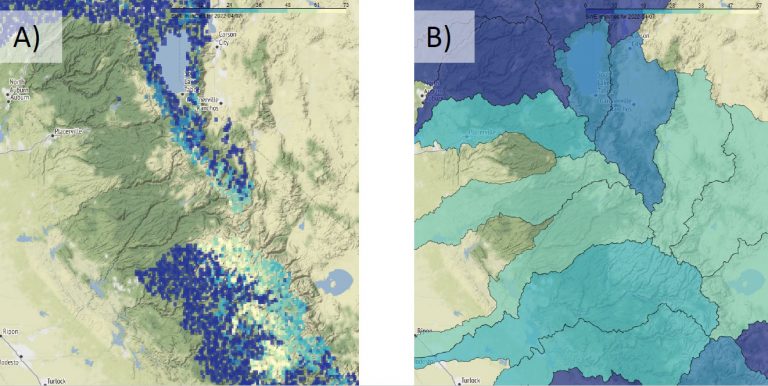The creation of a new machine learning tutorial based on a national snow model from researchers at The University of Alabama and the University of Utah has been funded by a grant from the Earth Science Information Partners.
Dr. Ryan Johnson, an artificial intelligence research scientist at the Alabama Water Institute, and his collaborator, Dane Liljestrand, a Ph.D. student from the University of Utah’s Department of Civil and Environmental Engineering, were awarded a $7,500 ESIP grant to create a tutorial using the GeoWeaver software package. It will demonstrate data pre-processing, model training, data ingestion, model prediction and a graphical interface for the end user to interact with model results. The six-month project will last through January 2023 and is also supported by the Cooperative Institute for Research to Operations in Hydrology, or CIROH, and the National Oceanic and Atmospheric Administration.
“Data-driven modeling is often referred to as a ‘black box’ with little to no communication of model processes,” Johnson said. “The ESIP grant emphasizing the GeoWeaver software package provides a key funding opportunity to increase the interpretability of the National Snow Model, which will support curriculum development and tools to transition the research into an operational water resources management environment.”
Melting snowpack is an essential source of water for many regions. Accurate understanding and portrayal of available water supply is crucial for water management efforts. The tutorial will utilize cutting edge machine learning techniques, public data sources and open-source software packages to advance snow-related products and streamflow prediction by allowing near-real-time snow-water-equivalent, or SWE, modeling inference. Such developments will improve water resources planning and management decision-making for a broad range of stakeholders.
The water supply from melting snow can be measured in the form of SWE, a common measurement used by hydrologists to gauge the amount of liquid water contained within a snowpack. Though classical, physically based models can predict snow depth and SWE values well in homogeneous landscapes, they are limited when it comes to spatial resolution, landscape heterogeneity and quality of input data.
This project aims to address the need for a high-resolution machine learning SWE prediction model that can adapt to non-homogenous settings. Machine learning is a branch of artificial intelligence and computer science that uses data and algorithms to imitate intelligent human behavior and gradually improve model prediction accuracy. Such systems can draw inferences from patterns in data and learn to adapt without being explicitly programmed to do so. Deep learning is a subset of machine learning that uses a complex structure of algorithms modeled after the human brain. Deep learning algorithms use a series of artificial neural networks which mimic the way biological neurons fire signals to each other in the human brain.
This project’s model employs a multi-model technique which utilizes gradient-boosted decision trees and a deep learning multilayer perceptron neural network model. Gradient boosted decision trees are a machine learning technique for optimizing the predictive value of a model through subsequent steps in the learning process. Each new piece of the decision tree works to minimize loss function, or the difference between the predicted value and target value.
“While we are continuously improving the internal model engine and looking at adding new input features from satellite remote sensing products, the current project is working towards transitioning the model into an operational setting that includes the production of mapping products to support water resources management planning guidance and ultimately, integrate into NOAA’s Next Generation National Water Model to support informed season-to-season water supply estimates in the drought-prone western U.S.,” Johnson said.

